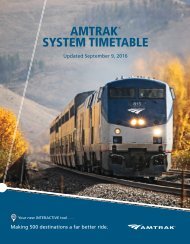Queens
northeast_queens_bus_study_-_final_9-28-15
northeast_queens_bus_study_-_final_9-28-15
You also want an ePaper? Increase the reach of your titles
YUMPU automatically turns print PDFs into web optimized ePapers that Google loves.
, Metropolitan Transportation Authority<br />
Running Time Modifications<br />
Running time is the amount of time scheduled for a bus to travel between two locations along a route.<br />
Variability in actual running times are a key indicator as to where problem areas might exist, and whether<br />
the schedule adequately reflects real road conditions. When scheduled running times are too short, buses<br />
will routinely arrive at stops and terminals late. When a bus begins to fall behind schedule, delays can be<br />
compounded by the increased loading times required for the additional passengers who have arrived after<br />
the scheduled stop time, who would normally just catch the subsequent bus. Insufficient running time can<br />
have a domino effect on later service if the bus arrives late to the final stop that it then leaves late for its<br />
next trip in the opposite direction.<br />
Conversely, when the scheduled running time is too long, travel time for passengers on board increases<br />
as the bus travels slowly to meet scheduled timepoints. Even worse, the bus may arrive and depart from<br />
the scheduled timepoints early, which means that someone who arrives the stop on time will have to wait<br />
until the next bus arrives. Adjustments to running times therefore can help improve performance for the<br />
adjusted trips, make later service more reliable, and decrease waiting and travel time for customers.<br />
Schedule planners can better track and correct these inaccuracies with the increased availability of data<br />
from Bus Time.<br />
To improve performance and schedule adherence, several modifications to scheduled running times have<br />
been implemented recently, and more will be implemented in the future. The adjustments are made to<br />
more closely match observed running times provided by Bus Time data. Running time modifications have<br />
been made on many routes this year, including:<br />
Summer 2015: Q12, Q13, Q17, Q28, Q36<br />
Fall 2015: Q15, Q16, Q17, Q20, Q26, Q31, Q36, Q43, Q44, Q46, Q48, Q76, Q88<br />
LONG‐TERM RECOMMENDATIONS<br />
Service Changes<br />
Limited‐Zone Bus Service<br />
Currently, many routes operate local and limited service in which the local bus makes every stop and the<br />
limited bus makes stops every half mile or so along the entire route. The half‐mile limited‐stop spacing<br />
pattern typically serves high bus‐to‐bus transfer locations or shopping and institutional destinations.<br />
However, many bus routes in Northeast <strong>Queens</strong> are be considered as subway feeder routes. There is a<br />
subgroup of customers who are solely travelling from the outer portions of the route directly to the<br />
subway. These customers from the outer “zones” typically have long travel times to their subway<br />
connection.<br />
“Limited Zone” service combines features of limited and express service. Buses make limited stops along<br />
the outer parts of the route and then operate non‐stop to terminals near subway stations. This pattern of<br />
service is not currently provided by the MTA. If the number of customers destined for the subway on a<br />
particular route reaches a full load at the outer zone of the route, it may be possible to designate some<br />
trips as “limited‐zone” trips. These limited‐zone trips would bypass subsequent stops and run directly to<br />
the subway, and perhaps operate only during the peak hours. A limited‐zone service could replace regular<br />
limited service if it is determined that a route is a good candidate for this service.<br />
68



